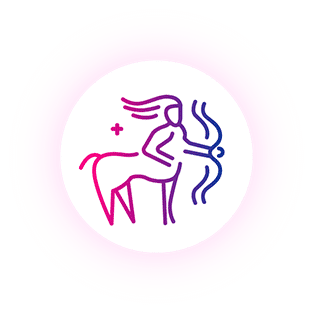The German philosopher Heidegger once said: “When you are wandering, you are at home”. For a Sagittarius, the saying “wiser the path than those who walk it” is relevant. Sagittarius’ are ready to venture and their nature for traveling, to move, to know more, to be curious and to experience first-hand is ingrained in their sign. This was the way of thinking for Columbus, Vasco da Gama, and Amerigo Vespucci. They all wagered in Sagittarius fashion and traversed an unknown path. The Sagittarius asks many questions, and a question is a type of initial motive, a curiosity towards landscape, and a deeper curiosity towards the mind. We don’t know the birth date of our ancestor Abraham (from the Bible), who is likely the first Sagittarius wanderer that connects the meaning of physical space and philosophical mental space (Lech-Lecha portion, Genesis 12:1). Abraham is commanded by God to leave his homeland, and to go “unto the land that I will show thee”, to abandon all he is related to and to drift into solitude and loneliness. This is a monotheistic message, since only a man who has experienced such solitude can grasp the singularity of God. In abandoning all, the only thing left is to acknowledge God exclusively. Being a Sagittarius is an entry ticket to a new mindset that begins with the abandonment of everything in order to reach the goal of a new reality. This also describes the decades long journey of Moses into the desert. The point of the journey is spiritual and therefore he cannot stay in one place. This is where another dimension of the Sagittarius comes into play, and it is hope. Alone, homeless and in solitude, the Sagittarius is on a journey and it is the path that grants him great hope for the future. In the case of Abraham, there is an explicit promise by God: “And I will make of thee a great nation, and I will bless thee, and make your name great; and be thou a blessing.” (Genesis 12:2). The journey starts with solitude but does not end in Israel but rather it reaches Egypt. Later on, the Israelites left Egypt in pursuit of spirituality: from the pyramids to Biblical Mount Sinai, from self-recognition to religious, collective and moral recognition. God, who is aware of Abraham’s difficult situation, point towards the stars and shows to Abraham the sky, to show Abraham that like the sky he is destined to become infinite. In Sagittarius fashion, solitude and loneliness become hope and optimism as Abraham is showed a great and impressive spectacle. Abraham was sent to deepen his relationship to God. He is the last of individuals and the first of believers. The Israelites’ journey started with the “Lech-Lecha” command and ended where the tribes safely settle down in the Promised Land. This journey is a representation of the Sagittarius as it is the abolishment of one home and the uprising of a new home for body, and mind. Abraham’s journey and the exodus of Moses are representatives of man’s free will to choose, to venture, to disconnect from the past and to look out into the future, into a new hope.
The journey is a change in mental spatial dimention; such a change is seen in Odysseus, in the humorous epos “Gulliver” by swift (Jonathan Swift is a Sagittarius – 10.12.1667), and Robinson Crusoe in Daniel Defoe’s novel. Robinson is a Sagittarius rebel, that instead of acquiring an established profession, he sails across the sea in an adventure, his ship sinks, and he finds himself in a survival situation to build himself a new world, without fear of nature but rather controlling it and making use of it. Marcel Proust ventures in his mind and conscience without treading a single step outside of his room. The Sagittarius understands that in order for change to occur, you must venture elsewhere. You are required to be distant from physical, political and cognitive dimensions. This distance allows a new perspective that could not be observed beforehand. In a journey like this, the venture outwards is observed in the growing separation between one’s original identity, and their new identity born within the journey.
The same can be said for author Robert M. Pirsig’s book, “Zen and the Art of Motorcycle Maintenance”, where the physical journey throughout America on a motorcycle is actually a philosophical and psychological journey that leads to changes in human nature and subconscious. Therefore, there is a psychological meaning in the change occurring for the Sagittarius rider. Behind the territorial change of traversing from a place to another there is not only a geographical map, but also a mental map. In other words, it is two simultaneous journeys in a single journey. The distance of the venture is set by the inner change of the rider and by his acceptance of meeting the unknown. The Sagittarius space is found within Jack Kerouac’s book “On the road” (1955), it is to be constantly in perpetual motion, and the road is a place you aspire to be in. More American artworks have been dedicated to the Sagittarius way, like “Song of the Open Road” by Walt Whitman, Bob Dylan’s songs and “The Road” by Cormac McCarthy. The road itself is the last thing that is left after everything else expires. “On the road” gives a voice to many people who are searching for themselves.
The reasons that lead a Sagittarius to wander seemingly are connected to domestic troubles in their youth. A feeling of lacking structure, perhaps a dysfunctional home, as for a man to leave his home there must have been some change in the home itself. The Sagittarius journey is derived originally from some defect (Professor Hana Nave, “Travellers” 2002), perhaps mental or material diminution at home, and forceful extrapolation from the old home. This loss cannot be made up for. Ingrained in the idea of nomadism is the inability to create a permanent space. If so, the meaning of Sagittarius is perpetual motion. This motion causes multiple perspectives, places, states and people. It is a freeing sense of liberty, from the travesty of the old home, from your old soul, and from your biological and historical roots. It is liberation from obligations to the family, social conventions and frameworks. To a Sagittarius nomad, there are no territorial aspirations, and therefore he is free of those conventions and obligations that determine countries and nations. The Sagittarius questions the conventional worth of land and materialism. The liberation is perpetual and therefore creates an endless journey. The immigration is vital, and so is the choice to go somewhere new. But as the Sagittarius immigrant takes on journeys, he cannot replace or get rid of himself. In travels, nomadism and immigration lies a paradox: The more you move forward, the more you move backwards. The nomad bears with him the same broken burden forever. It’s hard and maybe even impossible to let go of the past. The physical movement from place to place has not the ability to change the psychological past, and it is not certain the journey will reach the wanted liberating finale. The Sagittarius is in a state of homelessness, being always on the road, as we said, the road is the home. It is a Jupiter therapy of two types of liberation: liberation from, and liberation to. Something twists within itself the idea of hope towards something new. Perhaps the road leads to a better destination, far beyond the original identity. A stranger in a new environment who’s locating its weakness points. That’s how Deleuze and Guattari described the nomad in their book “A Thousand Plateaus”, he does not choose to go out on a journey, rather he lives when he is on the journey and chooses to be either in it or outside of it. Liberated and always towards some sort of physical movement, leaving him always “nowhere” but “towards somewhere”.
The Sagittarius moves us from his geographical nomadism into a far psychological depth of a wandering soul. The travels are a journey from outer reality into conscious change which cannot occur without meeting new aspects, strangers. Without strangers, and the different, one cannot change and will stay put in his personality. Meeting the stranger is the motive to change and form a new identity. The physical becomes mental. One cannot return home from the journey, the Sagittarius has already transformed and is no longer wanted in the psychological state of the old home. Even if he goes back to the same place from which he left, it is no longer the same. The lack of a home might not be a hindrance, but rather liberation from a blockade stopping change and the creation of new identities. “Panta rhei” said Hercalitus, “Everything flows”, “No man ever steps in the same river twice”. The Sagittarius returns home (Nave, “Travellers” 125) after he has changed, but home is no longer the home he remembers. For the departure of the old home is the loss of a previous identity, or more accurately, liberation from it. The addiction to nomadism is the acquiring of new identities that reflect on the environment around. The loss of an identity is liberation of the original home’s norms. The immigration plays on the aspect of compensation of the Gemini. Immigration is adaptation, change of language, and that is the Gemini in their essence. The Sagittarius, therefore, is much more like Agnon (Shai Agnon) than Odysseus. Mythological Odysseus returns after his travels to rule his land.
Agnon claims that in his tales, there is no returning home, the moment of departure is deterministic because of the lack of mental ability to return. Of course it requires a large amount of past events for a Sagittarius to depart on a journey, where he sees an adventure full of hope and answers. Moreover, the journey keeps the traveller always young. Maybe here the polarity of Gemini appears within the Sagittarius. Travelling is also a sort of mental mechanism to allow one to stay young, to stay expecting, a sort of optimism towards the future and new places, to start anew. Like a child, the Sagittarius will forever be young as long as he is on a journey. It is a sort of psychological warfare with time. The issue is that the past will never return, and the future may never be, as it might be an illusionary future of hope, feeding off the childhood pain in the previous home. The journey is a coping mechanism.
To the peak of distance reaches Don Quixote by Cervantes, where his departure manifested with his disillusioned ties with reality. After reading books of knights and becoming mad, he continued the justice war of the Sagittarius knight, thus his journey becomes the extreme of astrological limits, a Sagittarius where space and imaginary objects are complete insanity, a mental illness. It might not be surprising that a Sagittarius named Joseph Conrad (3.12.1857) in his famous novel “Heart of Darkness” (1899) describes a journey along an African river into the heart of the wild jungle.
It is the search for mysterious and terrifying Kurtz. It is definitely a Sagittarius journey, but the time on the ship down the river is actually a deep dive into the depths of the soul and an attempt to find the questions surrounding identity. The further the ship sails into the black continent, so does deeper the psychological dive of Conrad’s hero, Charles Marlow, on his ship, “Nellie”. The crusades of the Christians are a Sagittarius journey binding geographical space with religion.







